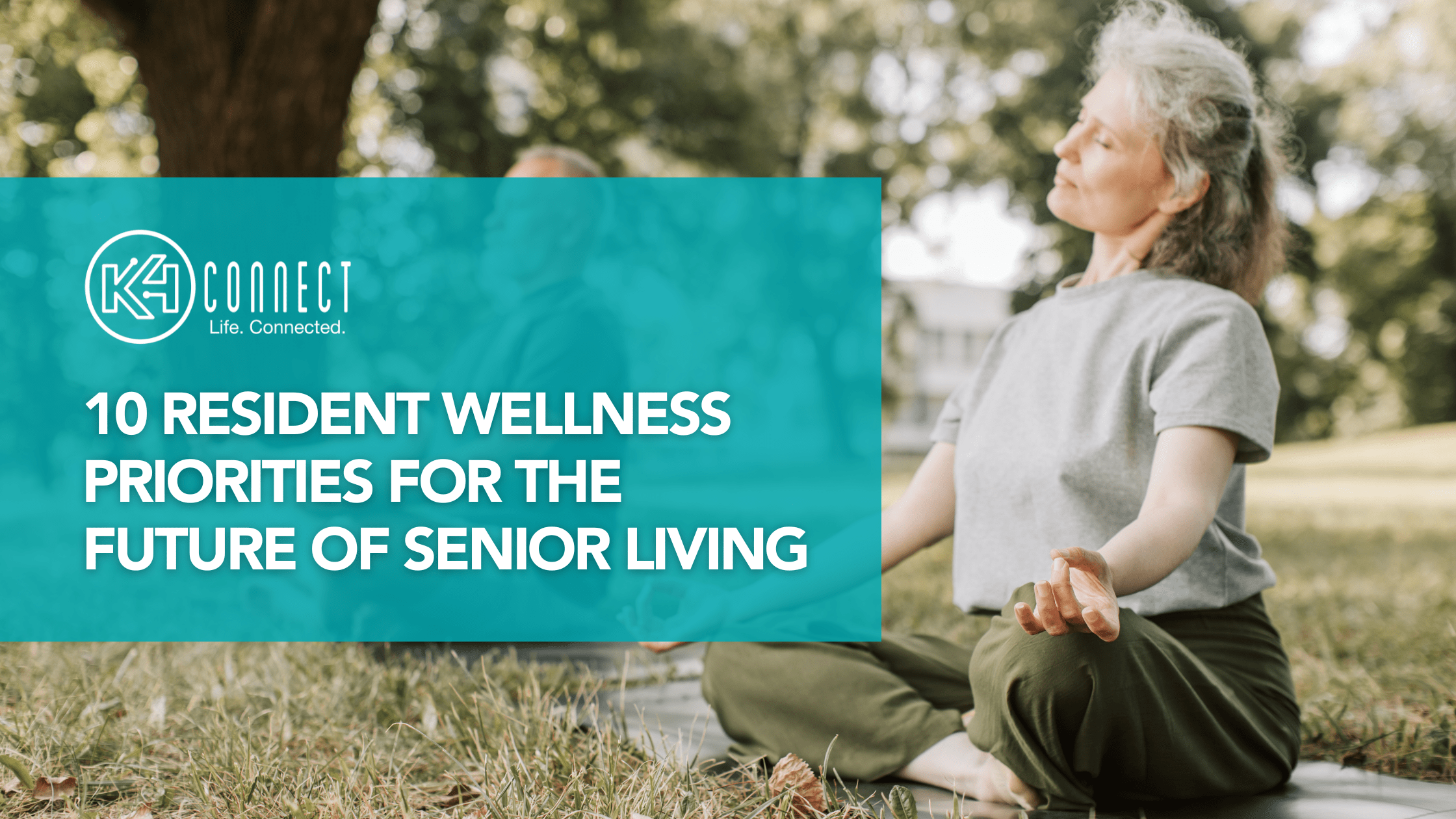Residents are placing a stronger emphasis on whole-person wellness, prompting senior living communities to rethink how they design experiences, services, and support. They’re looking for environments that care for more than just physical health. They want communities that also nurture mental, emotional, and social well-being.
As expectations continue to evolve, longevity management is emerging as a guiding framework, one designed to support a longer, healthier, and more fulfilling aging journey. This means delivering personalized support that promotes vitality, connection, and purpose throughout every stage of aging. In this blog, we explore 10 key wellness priorities shaping the future of senior living and reflecting what residents value most in their daily lives.
Personalized wellness plans are becoming increasingly important to residents who want care that reflects their unique needs and lifestyles. Whether it’s a fitness routine that builds strength, a meal plan that fits specific dietary needs, or mental health resources aligned with individual values, these customized approaches promote deeper engagement and long-term well-being.
According to McKnight’s Senior Living, technology will play a pivotal role enabling this level of personalization. Smart home systems, telemedicine and predictive analytics are making it easier for aging adults to actively participate in managing their health. From AI-driven care recommendations to data-informed wellness programs, these tools help communities deliver more relevant, responsive support tailored to each individual.
1. Personalized Wellness Plans
Technology and Artificial Intelligence (AI) are transforming senior living by enhancing safety, improving health monitoring, and fostering greater independence. These innovations provide residents and caregivers with tools that make daily life easier and healthcare more proactive.
Key benefits include:
- Continuous, passive health monitoring through wearable devices
- Smart home integrations that increase safety and confidence
- Virtual healthcare access via telehealth services
- AI-driven data analytics to predict health issues before they arise
Together, these technologies enable more personalized care and empower residents to live with confidence and autonomy. Care Indeed states that integrating technology and AI in resident care has led to better health outcomes and improved quality of life.
2. Technology Integration for Wellness
As residents continue to prioritize their well-being, holistic fitness programs in senior living communities are increasingly focusing on strength, balance, and flexibility to promote independence and overall health. A few popular activities in resident fitness programs include yoga, walking clubs, resistance training, and aquatic exercises.
The Centers for Disease Control and Prevention (CDC) recommends:
- 150 minutes of moderate-intensity movement per week like brisk walking, or 75 minutes of more vigorous activity such as hiking or jogging
- Practice strength building exercises, like chair squats or light weight training at least twice a week
- Balancing and flexibility exercises, such as stretching or walking heel to toe, are also essential for preventing falls and staying mobile
By offering diverse, accessible fitness programs that support strength, balance, and flexibility, senior living communities help residents stay active, independent, and engaged as they age.
4. Mental Health and Cognitive Wellness
Mental and cognitive wellness are becoming essential components of resident care. More and more older adults are prioritizing their emotional well-being, seeking communities that foster mindfulness, reduce stress, and support long-term brain health. These initiatives not only provide engagement and purpose but have been shown to reduce the risk of cognitive decline and dementia. For example, research such as the ACTIVE study, has demonstrated that consistent participation in cognitive training can help older adults retain their mental abilities for years.
By embracing mental health care and promoting lifelong cognitive engagement, senior living communities are empowering residents to take an active role in their overall well-being. This shift reflects a broader trend: aging is no longer just about managing illness, it’s about thriving, thinking clearly, and feeling emotionally supported at every stage of life.
5. Social Connection and Community Engagement
Community and social engagement are fundamental to supporting emotional well-being in senior living environments. Meaningful connections help reduce feelings of loneliness and depression, which are common challenges among residents. About one fourth of the older adult population are solo agers, which are those who live alone without a partner, and are childless. 42% of solo agers are not satisfied with their life and have poorer mental health than those in the “supported agers” category.
To nurture these relationships, many communities provide diverse opportunities for interaction and involvement. These may include interest-based clubs, group outings, volunteer initiatives, and regularly scheduled events such as game nights, gardening groups, and holiday celebrations.
Some benefits of social engagement include:
- 43% lower risk of developing dementia
- 32% lower risk of depression
- 50% lower risk of mortality
- 20% improvement in cognitive function
By creating spaces for authentic connection, senior living communities are not just offering entertainment, they’re building support systems that contribute to healthier, happier lives.
6. Nutrition and Enjoyable Dining Experiences
Nutrition and dining experiences are foundational to the health and happiness of residents. As individuals age, their nutritional needs evolve, and ensuring adequate nutrition is vital for maintaining physical health, promoting longevity, and supporting mental well-being. Malnutrition in older adults can lead to various health issues, including decreased immune function, poor wound healing, and increased risk in falls.
To address these challenges, many communities are adopting restaurant-style dining experiences that allow residents to choose when and what they eat. Menus are crafted with input from dietitians to meet diverse dietary needs while still delivering flavorful, satisfying meals. Moreover, dining in these communities also serves as a social activity that fosters connections among residents.
Whether it’s casual conversations over breakfast or laughter during themed dinner nights, communal dining helps build a sense of belonging. This social aspect of dining plays a critical role in promoting a positive, community-centered atmosphere that supports both mental and emotional health.
7. Creative and Leisure Activities
Research shows that participating in creative activities can effectively reduce stress, boost cognitive function, and foster a deep sense of purpose; benefits that become especially meaningful as we age. In senior living communities, involvement in creative and leisure pursuits such as arts and crafts, music, gardening, writing, and book clubs enriches residents’ well-being. These activities provide not only joy and a sense of accomplishment but also stimulate the mind, uplift mood, and support mental health by helping to alleviate symptoms of anxiety and depression.
8. Education and Lifelong Learning
Lifelong learning is becoming an essential part of senior living communities, offering residents opportunities to stay mentally engaged, curious, and connected to the world around them. For example, one study found that older adults who learned quilting or digital photography had more memory improvement than those who only socialized or did less cognitively demanding activities. This highlights the powerful impact of continuous learning on cognitive health.
The benefits of continuing education are clear:
- Improved memory
- Enhanced mental agility
- Engagement with community
By providing access to workshops, lectures, and skill-based classes, senior living communities can support mental stimulation, boost confidence, and encourage residents to keep growing at every age. These benefits are further amplified in intergenerational living communities, where residents can learn alongside and from younger generations. Whether its technology tutoring, mentorship programs, or shared creative products, these cross-generational connections foster a sense of purpose, reduce feelings of isolation, and promote a deeper sense of belonging for all ages.
9. Access to Nature and Outdoor Spaces
Access to nature and outdoor spaces plays a vital role in improving both mood and physical health, especially for older adults. Senior living communities that provide gardens, walking trails, and outdoor wellness classes engage residents with opportunities to stay active, socialize, and connect with nature.
Regular exposure to these outdoor environments not only enhances mental well-being by reducing symptoms of anxiety and depression but also encourages physical movement, which is crucial for maintaining mobility and overall health in older adults. Spending just 30 minutes outdoors a few times a week can lead to better heart function and lower the risk of heart-related illnesses.
10. Spiritual and Cultural Engagement
Spiritual and cultural enrichment offers residents meaningful ways to connect with their values, faith, and heritage, helping to deepen their sense of identity and purpose. For many, spiritual practices offer comfort, hope, and a way to connect with something greater than themselves.
Activities such as interfaith gatherings, cultural festivals, storytelling, and heritage programs allow residents to express themselves fully, build community bonds, and experience joy through shared traditions. By supporting diverse belief systems and embracing inclusive cultural celebrations, senior living communities create welcoming spaces where everyone feels respected and honored.
Aging Well, Together
Residents are redefining what it means to age well, placing value not only on physical health but on whole-person wellness that includes mental, social, emotional, and spiritual fulfillment. They are drawn to communities that foster creativity, lifelong learning, personalized care, meaningful engagement, and a strong sense of belonging. As these priorities continue to evolve, it is essential for senior living communities to grow alongside them, creating environments that support the full spectrum of well-being and promote a vibrant, connected lifestyle.
The future of senior living is here, and it’s powered by connected technology, personalized care, and meaningful engagement. K4Connect helps communities bring this vision to life through AI-driven platforms that elevate resident wellness, empower care teams, and simplify operations. Ready to see what’s possible? Schedule a demo and start building a smarter, more connected community today.

